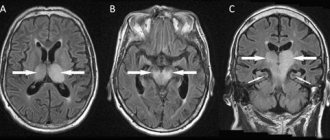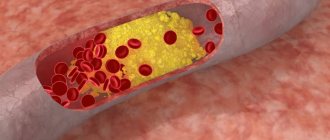Multiple sclerosis has a long latent period and the loss of nerve fibers before the manifestation of pathology can be 10 - 20%. The initial stage of the disease in most cases occurs without symptoms and without timely detection of the disease. Correct diagnosis, selection of medication and therapy at an early stage of the disease restrains its further acceleration and relieves disability.
What increases the risk of multiple sclerosis in women?
The female body, more than the male body, is susceptible to autoimmune diseases, which include multiple sclerosis. Why is the disease so selective and prefers the fair sex?
Advertising:
There is no explanation for this fact other than gender. Hormonal and immune changes in the body: phases of the menstrual cycle, pregnancy, childbirth, viruses that break the immunity of women, genetic features combined with other causes of the disease more often trigger the disease.
Women's bodies are predisposed to a “jump” in the permeability of the blood-brain barrier
. Periodic use of hormonal contraceptives and menopausal changes (estradiol production stops) lead to the entry of unwanted particles into the brain.
Any viral infection under these conditions is aimed at destroying cells of the nervous system.
It is well known that gender determines differences in the brain of the nervous system, from genetic to cellular. The emergence and development of MS occurs under the influence of sex hormones
, this nuance distinguishes and facilitates the course of the disease in women, unlike men.
Auditory or visual hallucinations may indicate a severe course of illness or be a consequence of stress, substance use, or alcoholic beverages. Read more in the article: “how to get rid of auditory hallucinations.”
What are the characteristics of multiple sclerosis in women?
The specifics of the disease are:
Advertising:
- in single or multiple damage to the myelin sheath of nerve tracts in different parts of the central nervous system;
- in violation of the conduction of nerve impulses;
- in the occurrence of severe autoimmune conditions.
Symptoms in women at the initial stage of multiple sclerosis indicate the presence of injured nerve endings in areas of the brain or spinal cord.
Retrobulbar neuritis, dizziness, and muscle weakness are caused by the involution of various functions of the nervous system that determine psycho-emotional and physical health.
The focus of the disease is formed by multiple sclerosis plaques in areas of myelin destruction. Plaques up to 2–3 cm in diameter are observed
, sometimes the MRI picture looks like “everything is like snow” in these plaques; spots of fiber damage can “stick together” into larger ones as the disease progresses.
During the examination, the patient has plaques of different levels of activity: old ones are present and new ones have appeared. Most likely, the answer to such a wide variety of symptoms of the disease lies in the ongoing atrophy of nerve fibers.
Hypothyroidism and hyperthyroidism are diseases that occur against the background of hypofunction and hyperfunction of the thyroid gland. With hypothyroidism, the thyroid gland produces insufficient hormones, and all internal processes slow down. Read more in the article: “hyperfunction of the thyroid gland, symptoms in women.”
Some notes on the course of the disease in women
Primary signs of multiple sclerosis in women are most often not detected, even when the patient has already developed MS plaques in the brain; the onset may go unnoticed, or it may immediately cause enormous damage to health; the disease can manifest itself in different forms.
Advertising:
Approximate options for recognizing the onset of the disease:
- due to weakened vision, sensory impairment;
- the pathology did not manifest itself in any way, but by chance an MRI study showed focal brain damage.
The mechanism of pathology development includes the process of compensation by intact nerve fibers for damage to a small amount of nervous tissue. Until the damage is 40 - 50%, focal neurological signs do not manifest themselves.
The typical course of the disease in women occurs with alternating moments of exacerbation and remission, in men there is a relentless intensification of the disease
. It is believed that female hormones block the dynamics of the development of astrogliosis and the nerve cell membrane is able to recover.
There is no classification of specific signs of multiple sclerosis for different patients. They are individual for each patient. The disease can reveal itself by one or a group of signs depending on the location of the foci of demyelination
.
Several reasons why you will use our services
- Individual treatment and approach to each patient.
- Properly designed nutrition that benefits the patient.
- Professional service and care for a sick person.
- Convenient location of the guesthouse from the city.
- Safe accommodation in a boarding house is provided by a specialized security holding company.
- All treatment is carried out according to the developed programs of our specialists, who have received high awards from statesmen and received certificates from the country’s Ministry of Health.
- Our boarding house has a reputation for being honest and decent in serving its residents.
What causes can trigger multiple sclerosis in women?
The etiology of multiple sclerosis considers the disease as multifactorial
. But the leading role is given to autoimmune processes, considering them as the primary cause of the disease. List of other reasons that may influence the appearance of this pathology:
Advertising:
- viral and bacterial infections;
- effects of toxic factors on the body;
- increased level of environmental radiation;
- negative effects of ultraviolet radiation on the skin;
- geography of permanent residence (cold climate);
- injuries and surgery;
- disturbance of psycho-emotional state;
- infectious and allergic diseases;
- vascular diseases;
- hereditary predisposition.
Symptoms of the initial stage of multiple sclerosis
- Visual impairment
. A response to the impact of the disease on the optic nerve, causing pain and double vision, the appearance of dry eye syndrome, a black spot in the center, nystagmus. - Reduced skin sensitivity
. The onset of the disease is indicated by: numbness in the arms and legs, tingling in the fingers, restless legs syndrome, spasms in the muscles of the limbs. - Hand tremors
. The disease at the initial stage is illustrated by trembling of the hands. The patient may find that it is difficult to fasten buttons and tie shoelaces. - Impaired coordination of movements
. Lesions on the spinal nerve can cause the following symptoms: dizziness, unsteadiness of gait, loss of balance. - Sudden influxes of heat or cold
. Damaged nerve fibers “signal” to the brain with soft impulses, and the patient is besieged by unpredictable waves of heat or cold. The manifestation of this symptom has no connection with the temperature of the environment. - Disorders of the pelvic organs
. Unexpected constipation, urination is disrupted, and a moment comes when the patient loses control over the processes of bowel movements and bladder. - Weakened memory and decreased intelligence
. Decreased memory and mental performance is the most convincing symptom of multiple sclerosis. - Changes in the length of the menstrual cycle
. Damage to nerve fibers causes dysfunction of the reproductive system and hormonal levels. - Increased fatigue
. The state of overwork and weakness immediately after a night's sleep is the body's response to multiple sclerosis.
Manifestations of sclerosis in women
The symptoms of multiple sclerosis in women, and the causes of their occurrence, are varied and depend on which part of the spinal cord or brain is affected. In addition, symptoms may appear or disappear, which complicates the diagnosis of the organism. Frequent signs of the development of early multiple sclerosis are:
- severe weakness in the limbs;
- constant fatigue of the body with minor loads;
- a sharp deterioration in a person’s visual functions with rapid recovery;
- numbness of the limbs;
- headache;
- dizziness;
- severe incoordination of movement;
- men may develop impotence;
- epilepsy appears.
If left untreated, these symptoms intensify, leading to:
- vision;
- speech patterns;
- swallowing problems appear;
- dry mouth;
- lack of sleep and desire to eat;
- severe decrease in mental abilities;
- urinary and fecal incontinence;
- dementia develops.
Only timely treatment and early diagnosis of this pathology can save a person from rapid disability and delay its onset. The manifestations of the clinical form of the pathology are directly related to damage to certain areas of the human brain and spinal cord. All of them are expressed by a sharp decrease in the muscle capacity of the victim, which requires outside help in some cases of the disease. If the disease is severe, paralysis of the limbs may occur. In such a situation, an integrated approach to treatment is required,
Nursing care for patients with multiple sclerosis
We understand that this pathology brings a lot of suffering for the patient and his relatives. The helpless state of the patient is to blame. Our boarding house for the elderly Vesna, located in the Moscow region and having a medical specialization, is ready to take on all the hardships of caring for your sick relative. Our professional approach will help and brighten up the life of a patient with multiple sclerosis. What are the difficulties of caring for a patient in the absence of special training, because patients tend to:
- chronic fatigue;
- rapid fatigue with minor physical exertion;
- forgetfulness;
- violation of the sequence of actions;
- failure to take necessary medications on time.
Therefore, he needs constant help and support. Impaired movement coordination and forgetfulness will lead to possible problems with personal hygiene. For such residents, our boarding house uses patronage services provided by professionals from our institution.
Patronage
What is included in patronage services:
- assistance in movement using special medical equipment;
- control over the time interval for taking medications prescribed by our specialists;
- change of bed linen;
- change of clothes with ironing and possible repairs, washing in the laundry of the boarding house;
- providing assistance in servicing the hygienic needs of the patient;
- accompaniment on daily walks;
- transporting the patient to undergo physical therapy;
- assistance with eating;
- manicure and pedicure, haircut.
In addition, patronage nurses will carry out the necessary injections and massage procedures.
Accommodations
For living in a boarding house, comfortable conditions and a cozy atmosphere have been created. Large, clean windows overlook the forest belt that surrounds the boarding house; from the window you can see the Moscow River, a cozy artificial recreation park, which contributes to the speedy recovery of mental disorders and improves the well-being of the patient.
Daily rounds of doctors make it possible to monitor the patient’s condition and, if necessary, provide him with first aid. Our patients with multiple sclerosis are constantly monitored by our staff.
Food for wards
The medical boarding house “Vesna” provides proper and healthy nutrition for our residents. The vegetables and fruits consumed by our patients originate from our greenhouse farms, which gives confidence in the absence of harmful substances and toxins in the prepared food. Depending on the patient’s condition, our boarding house nutritionists develop special calculated nutrition programs. These approaches to this problem provide unique assistance in treatment and improve the condition of the patient’s internal organs. Nutrition has an individual purpose, which is controlled by the attending physicians.
Procedures
The following procedures and measures are provided for patients with multiple sclerosis:
- massages of limbs that have lost their sensitivity;
- water treatments using medicinal herbs, mud and specially designed physical development programs;
- classes with wards and training them to independently maintain hygiene standards;
- methods of Eastern therapy to restore the patient’s psycho-emotional state, which leads to strengthening of the psyche and restoration of memory;
- development of reflex actions, which makes it possible to use skills at a subconscious level;
- acupuncture.
Staff of the boarding house "Vesna"
All personnel undergo annual certification courses, which makes it possible to fully control their professional training. Only specialists with higher medical education and at least 5 years of experience in medical institutions are hired to work in our boarding house. All these approaches to the selection of employees bring quality service to the patients of our boarding house.
Symptoms of the initial stage
The disease manifests itself in different ways. It all depends on the location of the progressive lesions. Damaged neuron processes (the upper layer of axons) form connective tissue (“sclerotic”) in the form of scars. These dead areas do not conduct nerve impulses from the central nervous system (or spinal cord) to the organs and peripheral areas of the body.
As a result, the nerve cells gradually die. This process is not reversible. Symptoms of multiple sclerosis in women at the initial stage:
- Loss of coordination of movements
. Accompanied by dizziness and loss of balance when walking. - Decreased sensitivity
. It is expressed by burning, tingling in the extremities or a feeling of tight skin. - Vision problems
. The patient suddenly begins to have difficulty seeing in one eye. The image becomes cloudy and colors become distorted. This is one of the most common symptoms of multiple sclerosis in women. - Disruption of the genitourinary system
. Urination becomes frequent or delayed. At the same time, urinary incontinence is observed, as well as disruption of the menstrual cycle. - Emotional disorders
. Frequent depression or sudden mood swings are accompanied by either tears or hysterical laughter.
The first manifestations of MS in young girls are associated with visual and hearing impairment. Constant weakness, severe fatigue, frequent headaches and abdominal discomfort are warning signs that cannot be ignored. As the disease progresses, paralysis of the limbs occurs, spreading to the entire body.
Causes and mechanism of damage
Lymphocytes are cells of the immune system; they produce antibodies that attack the myelin, the protective sheath of the nerves. This triggers the inflammatory process, as a result of which myelin is replaced by connective tissue, and the transmission of nerve impulses is disrupted. Despite the more or less clear mechanism of the development of the disease, the exact causes of MS are unknown. There are only theories, each of them has advantages and disadvantages. One of them says that the disease develops as a result of a combination of genetic predisposition and negative environmental factors. Scientists note that the causes of the disease depend to some extent on age.
How to understand that you are sick?
The initial stage of multiple sclerosis is characterized by alternating relapses (attacks, exacerbations) and remissions. MS in most cases (75-85%) begins in a remitting form. Common symptoms of early-stage multiple sclerosis do not differ between women and men and include:
- sensitivity disorders;
- movement coordination disorder;
- ocular movement disorders (nystagmus);
- sexual and sphincter dysfunctions;
- inflammation of the optic nerve is often present.
In most cases, early stage symptoms subside within 6-8 weeks, but can sometimes leave a permanent abnormal neurological finding or some degree of disability. The ability to reverse the effects of multiple sclerosis in women usually decreases as the disease progresses. The periods of alternating attacks and remission last about 5-15 years. Inflammatory activity on MRI at this stage is the highest.
- MS is a complex disease. It takes about 7 years from the onset of the first symptoms in women in the early stages to the diagnosis of multiple sclerosis. So what should you focus on? What signs are a reason to see a doctor? Changes in sensation in the limbs: tingling, trembling, numbness in the legs;
- sensations resembling an electric shock, moving along the spine or radiating to the limbs.
Dizziness in MS has an uncharacteristic course and is often accompanied by loss of limbs and pins and needles throughout the body. What is multiple sclerosis like and how to live with it, how the first symptoms appear - a woman’s view of the problem from the inside:
Multiple sclerosis is a chronic disease
So, the first word in our definition is “chronic.” This means that your disease will remain with you for life. It will not go away; it will not be possible to cure it completely with today’s level of medical knowledge, no matter who tells you. But this does not mean that it is impossible to treat multiple sclerosis. It is absolutely necessary, yes throughout your life, but you will have to remember this all the time, but with treatment, as a rule, this disease is kept under control. On forums on the Internet, in various articles by ignorant people, you can find frightening pictures of the future patient: “you will become disabled in the very near future, you will sit in a wheelchair, you will not be able to move, breathe, speak, eat, etc. and so on.". “Have you got multiple sclerosis? - Consider that your life is over, don’t torture others, leave your family, quit your job. Children?? What are you doing!? What kind of children, if you get pregnant, you will not live to see the end of it, and you will definitely pass this terrible disease on to your child by inheritance.” This is often what a patient hears when encountering the disease for the first time. It’s surprising to hear this at the end of the first quarter of the twenty-first century.
Firstly, you need to realize that there are a lot of people with chronic diseases, they are all around, they live with you, in the subway a third of the car is people with chronic diseases, on planes, trains - everywhere - patients, people with certain health problems . People constantly take medications for various diseases: diabetes, bronchial asthma, rheumatoid arthritis, hypertension, heart, lungs, stomach, liver, joints, etc. And the number of people living with chronic diseases is growing steadily. Yes, and it is already difficult to say that there are true diseases, and that there are changes in the body associated with the development of society, the socialization of a person. On the other hand, life expectancy and well-being of humanity in developed countries is also growing steadily. Therefore, we can say a seditious thing: if you have a chronic disease, then you are a modern, civilized person. Now you need to expand your knowledge, read literature, learn to influence your life yourself, and not remain under the control of the external environment.
Secondly, a chronic disease requires constant treatment. Treatment for multiple sclerosis is varied, combining medications, lifestyle changes, interactions with family and co-workers at work. Treatment can be roughly divided into two unequal parts: the first - the main part - the so-called course-modifying drugs for multiple sclerosis. They have the abbreviation PITRS. A medicine from the DMT group is prescribed by a doctor. And not just a doctor, but a neurologist, and not just a neurologist, but a specialist in multiple sclerosis. If a specialist has established a diagnosis of multiple sclerosis, then he is obliged to prescribe DMT. That is why we, specialists in multiple sclerosis, are so careful and attentive to diagnosis. We try to establish a diagnosis as early as possible because DMTs are most effective in the early stages of the disease. But also, if we say “A”, having established a diagnosis of MS, then we must also say “B” - prescribe one of the drugs from this group. In total, there are currently about two dozen medicines (not counting generics) belonging to the DMT group. And the vast majority of them are synthesized, researched and released to the market only for the treatment of multiple sclerosis and for no other diseases. The main task of PED is to prevent the disease from progressing, so that you do not have exacerbations, new lesions in the brain and spinal cord, and disturbances in the functioning of the body do not accumulate (disability).
The second word in our definition is “demyelinating.” Demyelination is a medical term. It determines the process of (de-)myelin breakdown. Myelin is a structure that forms the sheath of nerves and nerve fibers. From our school anatomy course, we know that the brain matter is divided into gray and white. The gray matter contains nerve cells - neurons, and the white matter contains their processes - axons. Each neuron has one axon. The length of the axon can be from a few millimeters to a meter or more. Through it, a nerve cell transmits nerve impulses—electrical discharges—to another nerve cell. In a second, many impulses rush along the axon. Thus, neurons communicate: transmit information, commands, inhibit neighboring neurons or, on the contrary, excite them. Axons, like electrical wires, have an outer sheath. The sheath consists of the membrane of another cell, the oligodendrocyte, repeatedly wrapped around the axon. It is this multilayered oligodendrocyte membrane, complex in its structure, in the brain and spinal cord that is called myelin. Myelin provides nutrition to the axon, maintains its structure, and protects the delicate axon from damage. Myelin is what gives the white matter of the brain its white color. The myelin sheath of the axon is not continuous, but is divided into small areas without a sheath - nodes of Ranvier. Unlike an electrical wire, through which electrical discharges move constantly and without interruption, a nerve impulse jumps from one unmyelinated area to another: from one node of Ranvier to another. This evolutionary achievement made it possible to greatly accelerate the transfer of nerve impulses along the axon. There are also many axons in the spinal cord: they are located more outward, and neurons (mainly motor neurons) are concentrated in the center. Axons also extend from motor neurons, but they go beyond the spinal cord and form motor nerves that give commands to the muscles to contract. All our movements completely depend on these commands. But in addition to the commands we send to our muscles, we receive a wide variety of information about the environment through vision, hearing, smell, touch and taste, both from our own body and also via nerves. Only these are no longer motor, but sensory nerves that extend from the skin, internal organs, retina, inner ear, nasal mucosa, etc. and go back to the spinal cord and brain. Each nerve carries many axons from many motor neurons in the case of a motor nerve and from sensory neurons in the case of a sensory nerve. Unlike the white matter of the brain and spinal cord, where all axons are covered with a myelin sheath formed by oligodendrocytes, only a portion of the nerves have such a sheath. It is formed outside the brain and spinal cord by other cells - Schwann cells. Thus, myelin is ubiquitous - it is a universal structure that forms a sheath around the axon and accelerates the transmission of nerve impulses.
Demyelination is the process of damage to myelin. Considering the above, it is clear that demyelination can occur in both the brain and spinal cord, as well as in motor and sensory nerves. In multiple sclerosis, demyelination occurs only in the brain, spinal cord, and optic nerve, where myelin is formed by oligodendrocytes. All other nerves remain intact (I remind you that myelin in peripheral motor and sensory nerves is formed by other cells - Schwann cells). Damage to myelin leads to a slowdown in the speed of nerve impulse transmission, and subsequently to damage to the axon itself (axon degeneration occurs) - in this case, the nerve cell can no longer transmit an impulse along its axon to another neuron.
But besides multiple sclerosis, there are many other diseases that lead to demyelination. They are primary (this includes multiple sclerosis), when the entire disease process is caused precisely by damage to the myelin. And secondary, when the disease has its own mechanism of development, for example cancer or rheumatism, and demyelination can occur as a complication of this underlying disease or its treatment. Therefore, we, doctors, try to carefully examine you, our patients, in order, firstly, to understand whether the myelin damage is primary here or whether my patient suffers from another, previously undetected disease, and demyelination is only one of the manifestations of such a disease. And, if demyelination is primary, then what kind of disease is it a manifestation of: multiple sclerosis or another, more rare, disease, for example, a neuromyelitis optica spectrum disorder.
Multiple sclerosis is a disease
What is a disease? Many doctors, scientists, and thinkers have puzzled over this question. There is a universally accepted WHO definition: a disease is a special type of suffering caused by damage to the body and its individual systems by various damaging factors, characterized by disruption of regulation, adaptation, and decreased performance. The definition is, of course, complex, but the main thing in it is that a disease is damage to the body or part of it by any damaging factors. Factors can be external to our body: bacteria or viruses, radiation, trauma, or they can be internal: genetic disorders, malfunction of the immune system (the so-called autoimmune process), etc. For a chronic disease to occur, several factors must act on a person at once, this also applies to multiple sclerosis: there must be external factors, for example, the northern zone of residence, white race, lack of vitamin D, the penetration of certain viruses and internal factors, for example, a combination of several tens or hundreds genes, malfunctions of the immune system, etc.
But in the first place in the definition is the word suffering. Indeed, any demyelinating disease is suffering, it changes life and affects a person physically. But the person himself, as an individual, pondering his suffering, studying the cause of his illness, worrying about the occurrence of the disease, the attitude of his family and friends towards him, inevitably suffers psychologically, sometimes becoming despondent, sometimes not accepting the disease. Can we help a sick person here, can we reduce his suffering? Yes we can. And the person himself can. Moreover, he must and simply must take care of himself. Don’t lose heart and make decisions not only for yourself, but also for the sake of your nearest and dearest, as well as for the sake of your descendants, who may not even be born yet.
So, physical suffering in the case of multiple sclerosis is a dysfunction: strength in the limbs or sensitivity in them may be reduced, coordination or vision may be impaired. But these disorders do not appear immediately, not with the first exacerbation, but after several, not at the beginning of the disease, but later. And this is true for the vast majority of our patients. And in order to delay, extend the time intervals between exacerbations, to prevent the disease from severely damaging the nervous system, and, as a result, to prevent the appearance of severe disorders leading to severe physical suffering, it is necessary to undergo treatment - receive a drug, be observed by a doctor. In addition to drug therapy, you need to lead a healthy lifestyle so that your lifestyle does not cause unnecessary physical suffering to your body.
Psychological suffering - this suffering is mainly associated with awareness of the disease: a person is very worried, and this is due to two reasons. Firstly, inaccurate information about the disease. The Internet is filled with inaccurate and sometimes false information about the disease. In addition to information sites, which often publish outdated articles, there are forums where they widely publish their opinions about treatment methods, and patients themselves evaluate the effectiveness of such methods. But on the forums, the percentage of patients for whom treatment was unsuccessfully selected or they themselves refused it for some of their own, internal reasons, is significantly higher than patients for whom the treatment was suitable and effective - they are rarely present on the forums, they do not need it. But people with severe disabilities are active in this environment and actively express their opinions and form an opinion about treatment as something optional and unnecessary. Therefore, soberly evaluate what you have read and still go to a specialist, otherwise your psychological suffering will only increase. Secondly, a chronic disease puts a line in a person’s worldview: life is divided into before and after the disease, and sharply, unambiguously. And there is a deep misconception in this. Clinical manifestations of the disease, what we call exacerbation (the first exacerbation is called debut) very often, in most cases occur later than the actual onset of the disease. Many people have foci of demyelination, their number is increasing, but the patient himself does not feel them, does not feel that he is unhealthy. An autoimmune process in the brain can develop for years before the first clinical manifestation. On the other hand, many people come to us without any disorders, but with randomly identified “unclear” lesions in the brain: this is due to the widespread use of MRI and the conduct of this examination, both according to indications and without them, independently. Therefore, the sharp boundaries between the healthy and the patient are blurred, especially when it comes to autoimmune diseases. You may have been sick for several years, but for the first time you felt the disease and consulted a doctor only now. Because of this, you cannot draw sharp lines: you have already been sick for several years, fundamentally nothing has changed for your body at the moment when the doctor diagnoses you, only your worldview changes, you psychologically understand, realize that you are now sick. However, chronic disease was and is - it is not a discrete process, but a continuous one, and we doctors cannot tell you when it began. Thus, the actual diagnosis is, on the one hand, a generalization of the processes occurring in your body and, on the other, the patient’s awareness of his suffering.
Multiple sclerosis is a disease of the central nervous system
What is the central nervous system? And why central? So is there another one? We will give answers to these questions in this section. So, the main function of the nervous system is to control the body. In humans, the nervous system has reached the greatest development compared to other animals on our planet. We should not forget that in addition to the nervous system, our body is controlled by the endocrine system, carrying out so-called humoral regulation through hormones. The nervous system consists of cells: neurons, which perform direct control, and glial cells, which provide an auxiliary supporting function. The cells located in the brain and spinal cord—all of their multibillion-dollar total—make up the central nervous system. Everything that is outside the brain and spinal cord belongs to the peripheral nervous system. In multiple sclerosis, demyelinating damage occurs exclusively in the central nervous system. Supportive glial cells are divided into two main types - astrocytes and oligodendrocytes. Oligodendrocytes form myelin, the protective sheath of the neuron process. It is myelin that becomes the main target of the immune system in multiple sclerosis.
There is a certain hierarchy in the central nervous system: the lower the neuron is located in the literal sense of the word, the more subordinate position it occupies. The cells of the spinal cord and their motor neurons play the role of transmitting nerve impulses to the muscles to perform simple movements. Cells of the cerebral cortex determine movement strategy (for example, go to the cinema) and tactics (a set of motor acts is formed to accomplish this goal: get up, get dressed, go outside). Each act is divided into complex movements (walking, opening a door with a key) and simple movements (flexion and extension, turning a limb, etc.). And everything goes down the hierarchy from top to bottom. Moreover, at the middle level in this hierarchy there are parts of the brain (for example, the cerebellum), which carry out fine tuning and ensure precision of movements. Therefore, if the focus of demyelination is located on the path of motor neurons, then the motor act may be disrupted: weakness of the limb or loss of coordination occurs.
In addition to performing movements, the central nervous system perceives information from the external environment through the senses: vision, smell, hearing, touch, taste. The greatest flow of information to the brain comes from the skin (sensation of hot/cold, sensation of touch) from the deep layers of the skin, muscles and joints (sense of position, vibration) and from the retina of the eye - perception of light and color, as well as from the inner ear - perception sound vibrations. From the surface of the body and joints, information is transmitted first to the spinal cord, and then to the brain, where, with the help of a complex processing process, complex images are formed in the mind, an understanding of the position of our body in space, etc. For example, when you take something with your eyes closed. or an object and recognize it by touch, then this is a complex process of perception, processing of information received by hand. In this case, each sensitive neuron is responsible for a strictly designated area of the body: only the tip of a finger or a section of the skin of the shoulder. Light in the retina activates certain cells using photons, which transmit information further along the optic nerve to the brain. Already in the visual (occipital) cortex of the brain, an image is formed from this stream of impulses, a person realizes what kind of object, landscape, face he sees in front of him. Therefore, when lesions with damaged myelin appear in the brain, the speed and synchronicity of the transmission of nerve impulses along numerous brain pathways is disrupted. This leads to loss of sensitivity zones on the body corresponding to the areas of responsibility of specific neurons. If the focus is in the optic nerve or visual cortex, then vision and color perception are impaired, and often not entirely, but in certain areas of the visual field.
Multiple sclerosis is characterized by focal lesions
I think more than once, if you told someone that you have multiple sclerosis, then your interlocutor would answer that he also has sclerosis - his memory is worthless. At the present time, it is difficult to say where this “sclerosis” came from. Usually, when an elderly person’s memory and speed of thinking are impaired, they say: “this old man has sclerosis.” However, in medical terminology, sclerosis has a fairly clear concept of “hardening, focus”, which has nothing to do with ordinary sclerosis. For example, atherosclerosis: the presence of plaques, hardening of “sclerosis” in the wall of the “athero” vessel. Impaired contractility of the heart, when it is not as elastic and contractile as before: “cardiosclerosis.” The term multiple sclerosis refers to the presence of scattered lesions. At the same time, sometimes in translated articles we can read the term “multiple sclerosis” - this is a literal, but in terms of meaning, not an exact translation of multiple sclerosis. Since the word scattered contains a very important meaning: lesions (or demyelinating plaques) appear in different parts of the brain and spinal cord - scattered in space and do not appear simultaneously, all at once, but gradually at irregular intervals - scattered in time. The combination of absent-mindedness in the appearance of foci (plaques) of demyelination in space and time is mandatory for making a diagnosis of multiple sclerosis; if this absent-mindedness does not exist, the diagnosis of MS is unlikely.
What is a focus: this is a mophrological term, i.e. By taking the brain of a patient suffering from multiple sclerosis, we will literally see and “probe” these lesions. The focus of demyelination or demyelinating plaque may be active, or it may be inactive and old. An active plaque, usually a newly emerging lesion, in which many inflammatory cells are located: lymphocytes, plasma cells, monocytes. These cells enter the plaque from a vessel (capillary). And the old inactive plaque consists of astrocytes and microglia and resembles a scar in its structure, clearly demarcated from the rest of the nervous tissue.
At the same time, with the development of new methods of imaging the central nervous system, primarily MRI, we can see these lesions “live” and track their development. There are several types of sources: inactive, active and “black holes”. A lesion, in general terms, is a small white spot on a T2-weighted MRI. T2 mode - when the brain is dark gray in color. The location of such lesions is important: for multiple sclerosis, it is more typical to be located in the central zone of gray color along the upper border of bright white color in the center of the brain. The white one in the center in the form of a horn is the ventricle, and it is white because it is filled with liquid (cerebrospinal fluid), which is white on T2 mode. The central zone, which is a solid dark gray color, is a collection of myelinated fibers called the corpus callosum. In addition to the T2 mode, there is another mode - FLAIR, in which the lesions are more clearly visible. FLAIR - when the brain is gray, and the cerebral cortex is light gray, the white matter is darker, but not as dark as on T2.
Having seen the lesions in T2 or FLAIR modes, the radiologist injects the patient with a contrast agent containing the element gadolinium. A “fresh” lesion that has just appeared on T2 is often indistinguishable from an old, inactive one. The peculiarity of the new lesion is that inflammation occurs in it. Therefore, a method was invented to detect this inflammation. Gadolinium penetrates from the bloodstream only into the site of inflammation, changing the image of the brain in another MRI mode - T1. In this case, a bright white lesion appears on the T1 image (T1+Contrast or T1+C or CUBE T1+C mode). T1 mode - when the brain is light, light-light gray, the cerebral cortex is slightly darker, the white matter is lighter.
In T1 mode, the usual lesions seen on T2 and FLAIR images are not observed. But, if you look closely, you can see that some of the lesions visible on T2 or FLAIR at the same slice level in T1 are visible as a dark spot (let me remind you that in T1 mode the white matter is light gray). This is called a “black hole,” which means that this lesion is old, that it is already several years old, and that in this place not only the myelin (the sheath of the neuron) has suffered, but also the axon itself (the process of the neuron), which takes place in the process neurodegeneration, which we begin to describe in the next section.
Multiple sclerosis is characterized by a neurodegenerative process
The difficult-to-understand term “neurodegenerative” means: “neuro” means nervous system, “denerative” means deteriorating. Therefore, the presence of a neurodegenerative process indicates damage to nerve cells. Demyelination is the process of breakdown of myelin (the sheath of the axon, nerve), and neurodegeneration is the presence of damage to the axon, the process of the nerve cell, and the nerve cell itself. Unfortunately, multiple sclerosis is not only a demyelinating process, although demyelination is a leading component in the development of this disease, but also a neurodegenerative process. We know about three main types of multiple sclerosis:
- remitting, covering up to 80% of patients;
- primary progressive - 10% of MS patients;
- secondary progressive - a type of course that occurs after several years or decades, or does not occur at all in patients with the remitting type of multiple sclerosis.
Of these three types, in relapsing-remitting patients the process of demyelination predominates, while neurodegeneration is expressed to a significantly lesser extent, especially against the background of properly selected treatment. In the primary progressive, the main process is neurodegenerative: on MRI we usually see few lesions, active lesions are rarely visualized on MRI, but at the same time, the course of the disease is steadily progressing without obvious exacerbations and remissions. A similar clinical picture is observed in patients with a secondary progressive course: again, there are no exacerbations. This type of course develops after many years, and sometimes decades, after the remitting type of course. MRI shows many old lesions (as opposed to the primary progressive type), but there are practically no active ones. While disturbances in movement, walking, coordination, vision, and sensitivity are steadily increasing. Therefore, with this type of course, the process of damage to the nerve processes and neurons themselves begins to predominate, and active inflammation, which primarily affects myelin, comes to naught. It is the irreversible damage to neurons and their processes that underlies the “accumulation” of neurological disorders and disability. Indeed, if at the beginning of the disease exacerbations often pass without a trace, the person completely restores all his functions, then over time, each exacerbation leaves its mark on the well-being of the patient: he retains certain impairments (numbness area, weakness of the limb, decreased vision in one eye etc.). This “accumulation” of disorders and disability can be significantly slowed down, or even practically stopped for years, only with the help of properly selected treatment with drugs that change the course of multiple sclerosis.
The main objectives of treatment at the early stage of the disease
At an early stage, the disease is asymptomatic or with a range of symptoms.
, confusing the picture of the disease.
Periods of serious condition alternate with moments of relative well-being. After the diagnosis is made, immunomodulatory therapy is immediately prescribed, pathogenetic agents and immunosuppressants are selected. Delayed administration of treatment reduces its effectiveness. It is advisable to quickly solve the following problems:
Advertising:
- stop the exacerbation of the disease;
- provide assistance to foci of autoimmune inflammation;
- prevent or temporarily delay the appearance of new exacerbations;
- reduce symptoms that make it impossible to work;
- plan activities to alleviate the illness.
Important information. In the center Pirogov tested the latest method of treating multiple sclerosis through stem cell transplantation and chemotherapy. The patient's immune system was completely removed and later restored using stem cells previously isolated from her own blood.
Prevention of sclerosis
Prevention of multiple sclerosis includes:
- Cigarettes and alcohol accelerate the destruction of neurons and can cause damage to the immune system.
- Monitoring your weight, avoiding strict diets and overeating.
- Avoidance of hormonal medications (if possible) and contraceptives.
- Refusal of large amounts of fatty foods;
- Avoid overheating. Alzheimer's disease - what it is, symptoms and signs, causes, treatment, stages.
Multiple sclerosis is an incurable disease that can lead to disability, but this is not a death sentence. It is important to diagnose the disease in time and follow all doctor’s instructions. Then a person has a chance to live to an old age and maintain good spirits. Primary prevention (directly aimed at preventing the disease) does not exist. You can protect yourself a little from multiple sclerosis or its relapses if you exclude any infections, stress, injuries, surgeries, and smoking.
Physical disability
Early signs of multiple sclerosis may fade, but sometimes patients notice changes in physical activity. This can be explained by a disruption in the passage of impulses from the muscles to the brain. First of all, it is increased fatigue. If previously it was easy to overcome the climb up the stairs or the road from home to work, then gradually this task becomes difficult to complete. Paresis develops, limiting movements, and over time the ability to train muscles, which is necessary to maintain motor activity, is lost. The progression of paresis and paralysis is the reason leading to the need to use assistive devices. Impaired motor activity leads to early wear and tear of the spinal joints, which only worsens the situation. In order to move, people with MS have to exert more effort even for basic movements. The overall situation is complicated by side effects associated with taking drugs for multiple sclerosis.
Mental changes
In this matter, not everything is so clear. In only a quarter of patients, mental changes are directly related to MS. In other cases, depression and frequent mood swings are associated only with awareness of the disease and possible prognosis, its complex course and treatment. Despite all treatment efforts, it is impossible to cure MS; it is only possible to curb its progression. A few days before an exacerbation, patients note increased irritability and mood swings. In the later stages of the disease, problems with concentration and difficulties with writing and counting are possible. In rare cases, personality changes and dementia may occur.
Infectious complications
Restricted mobility is a predisposing factor for infectious complications. Typical complications include:
- urinary tract infections, which can be explained by incomplete emptying of the bladder;
- pneumonia, due to congestion and impaired ventilation of the lungs, accumulated mucus can become a breeding ground for the development of bacteria;
- the formation of bedsores - ulcers on the skin that become infected, and in severe cases can cause sepsis.
Does MS give you a disability?
MS is often disabling, but group identification can be difficult due to the large number and variety of symptoms. Even the same clinical form can occur differently. Therefore, the group is established on the basis of motor activity disorders:
- Group I is indicated for pronounced movement disorders;
- Group II is given for severe disorders of the motor system;
- Group III is given when a person remains able to work and has mild or moderate movement disorders.
The timing of the transition to disability varies: in some patients, motor impairments appear in the first years after the onset of the disease, in others much later. There are cases where disability was assigned decades or more later.
Prevention
There is still no consensus on what exactly leads to the development of multiple sclerosis, but predisposing factors have been identified. And just their elimination is a means of prevention if there is an existing predisposition. These recommendations should also be followed when the first signs of multiple sclerosis appear:
- Lifestyle
This is a key factor in helping prevent the development of MS. First of all, this is ensuring sufficient physical activity, the main thing is that it is constant, but you should not abuse training. It is important to give up bad habits, avoid stress and emotional stress.
- Nutrition
The diet should contain a wide variety of fruits, vegetables, and herbs. It is necessary to limit the consumption of animal fats; it is better to replace them with dishes high in Omega-3 acids, that is, vegetable oils and fatty fish. It is necessary to exclude sweets, spicy, smoked, fatty cheeses, as well as red meat from the diet.
- Prevention of infectious diseases
Infections of any type, even ordinary acute respiratory viral infections, are a signal that activates the immune system, and its excessive activity affects the myelin sheath of the nerves. Accordingly, preventing infections will help avoid complications and rapid progression of the disease. Prognosis MS is a disease that constantly progresses, but the rate of its development varies greatly.
Forecast
The disease depends on many factors: lifestyle, timely diagnosis and treatment initiated.
However, the acute form of MS, which affects one in four patients, can shorten life expectancy by 4-6 years. However, this is the exception rather than the rule. And if you follow the doctor’s recommendations and properly selected therapy, life expectancy does not decrease. And if the diagnosis was made to a person at the age of 35-40, there is every chance of living fully and actively until 70 years old, or even more. Text: Yulia Lapushkina.








